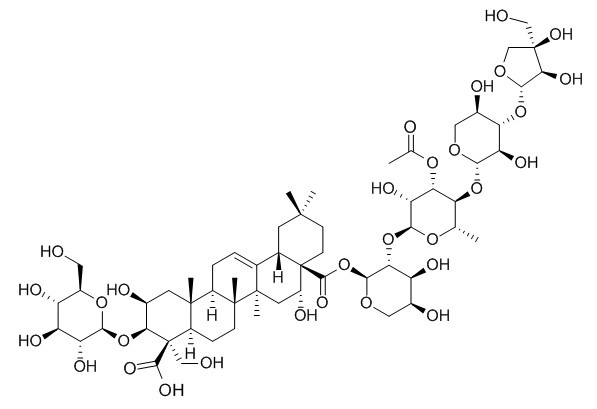3''-O-acetyl-platyconic acid A (Platyconic acid B)
Standard reference
Inquire / Order:
manager@chemfaces.com
Technical Inquiries:
service@chemfaces.com
Tel:
+86-27-84237783
Fax:
+86-27-84254680
Address:
1 Building, No. 83, CheCheng Rd., Wuhan Economic and Technological Development Zone, Wuhan, Hubei 430056, PRC
Providing storage is as stated on the product vial and the vial is kept tightly sealed, the product can be stored for up to
24 months(2-8C).
Wherever possible, you should prepare and use solutions on the same day. However, if you need to make up stock solutions in advance, we recommend that you store the solution as aliquots in tightly sealed vials at -20C. Generally, these will be useable for up to two weeks. Before use, and prior to opening the vial we recommend that you allow your product to equilibrate to room temperature for at least 1 hour.
Need more advice on solubility, usage and handling? Please email to: service@chemfaces.com
The packaging of the product may have turned upside down during transportation, resulting in the natural compounds adhering to the neck or cap of the vial. take the vial out of its packaging and gently shake to let the compounds fall to the bottom of the vial. for liquid products, centrifuge at 200-500 RPM to gather the liquid at the bottom of the vial. try to avoid loss or contamination during handling.
Processes2022, 10(10), 2008.
LWT2020, 124:109163
Food Funct.2022, D1FO03838A.
Food Chem X.2024, 24:101794.
J Pharm Pharmacol.2024, 76(10):1239-1268.
J Appl Toxicol.2024, jat.4615.
J Food Drug Anal.2023, 31(2):254-277.
Int J Mol Sci.2015, 16(1):1232-51
Pharm Biol.2017, 55(1):360-366
Biocell2023, 47(8):1793-1802
Related and Featured Products
Food Chemistry.2011 Nov 15;129(2):645–651.
HPLC-ELSD analysis of 18 platycosides from balloon flower roots (Platycodi Radix) sourced from various regions in Korea and geographical clustering of the cultivation areas[Reference:
WebLink]
METHODS AND RESULTS:
An effective HPLC method to analyse platycosides from the balloon flower root was developed using ELSD. The optimum resolution of the platycosides was achieved on an ODS column with gradient elution of eluent A, 30 mM ammonium acetate buffer (pH 4.81): methanol: acetonitrile = 75:5:20 (v/v/v), and B, 69:5:26 (v/v/v). Amongst 18 platycosides, platycoside E showed the highest content, followed by polygalacin D2 and 3''-O-acetyl-platyconic acid A. The sum of these three compounds was recommended for quality control of balloon flower root for medicinal purposes. The samples could be clustered into groups based on platycoside content.
Group I, characterised by a high concentration of platycosides, was located near the west coast of Korea, whereas group II, characterised by a low concentration of platycosides, was located inland or in mountainous area.
CONCLUSIONS:
The method could be used to control the quality of balloon flower root.



